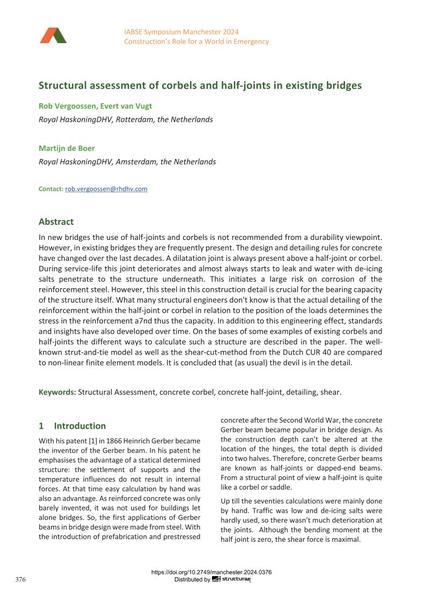Structural assessment of corbels and half-joints in existing bridges

|
|
|||||||||||
Détails bibliographiques
| Auteur(s): |
Rob Vergoossen
(Royal HaskoningDHV, Rotterdam, the Netherlands)
Evert van Vugt (Royal HaskoningDHV, Rotterdam, the Netherlands) Martijn de Boer (Royal HaskoningDHV, Amsterdam, the Netherlands) |
||||
|---|---|---|---|---|---|
| Médium: | papier de conférence | ||||
| Langue(s): | anglais | ||||
| Conférence: | IABSE Symposium: Construction’s Role for a World in Emergency, Manchester, United Kingdom, 10-14 April 2024 | ||||
| Publié dans: | IABSE Symposium Manchester 2024 | ||||
|
|||||
| Page(s): | 376-384 | ||||
| Nombre total de pages (du PDF): | 9 | ||||
| DOI: | 10.2749/manchester.2024.0376 | ||||
| Abstrait: |
In new bridges the use of half-joints and corbels is not recommended from a durability viewpoint. However, in existing bridges they are frequently present. The design and detailing rules for concrete have changed over the last decades. A dilatation joint is always present above a half-joint or corbel. During service-life this joint deteriorates and almost always starts to leak and water with de-icing salts penetrate to the structure underneath. This initiates a large risk on corrosion of the reinforcement steel. However, this steel in this construction detail is crucial for the bearing capacity of the structure itself. What many structural engineers don't know is that the actual detailing of the reinforcement within the half-joint or corbel in relation to the position of the loads determines the stress in the reinforcement a7nd thus the capacity. In addition to this engineering effect, standards and insights have also developed over time. On the bases of some examples of existing corbels and half-joints the different ways to calculate such a structure are described in the paper. The well- known strut-and-tie model as well as the shear-cut-method from the Dutch CUR 40 are compared to non-linear finite element models. It is concluded that (as usual) the devil is in the detail. |
||||
